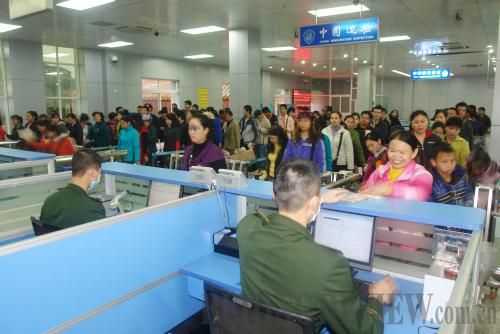|
There can be no question this new arrangement will benefit both sides. China and ASEAN member countries are mostly developing countries; thus CAFTA does not represent the interests of one country over any other member nations. This is, by far, one of the most unique aspects to this particular FTA.
A bright future amid challenges
 |
|
CUSTOMARY WORK: Chinese workers and entrepreneurs queue for customs inspection in Dongxing, Guangxi, on January 1, before travelling on to neighboring Southeast Asian countries (XINHUA) | But CAFTA naturally has its shortcomings. The most prominent is that ASEAN countries' trade with China will revert from a surplus to deficit. For many years, ASEAN nations have maintained huge trade surpluses with China. These have generated increases in employment and foreign exchange reserves in ASEAN countries. With the acceleration of tariff cuts within CAFTA, however, this advantage is disappearing.
From January to October 2009, ASEAN enjoyed a trade surplus of $940 million to China—a sharp drop compared to $6.28 billion during the same period in 2008. In addition, it is believed Beijing will soon turn to trade surplus in its trade with ASEAN. Its competitive manufactured goods will be exported to ASEAN in large numbers thanks to the zero-tariff policy in CAFTA. At the same time, Chinese companies will soon get familiar with and make full use of CAFTA's preferential policies.
As a result, ASEAN officials have begun to worry about trade imbalances. Big changes in trade volume may also lead to trade remedy measures and non-tariff barriers, with disputes following.
Another challenge includes addressing concerns by some ASEAN countries that they will not be able to weather many aspects of CAFTA. Associations of some industries in Indonesia, for example, have requested that the government delay the implementation of CAFTA's zero-tariff policy. They voiced fears that the influx of cheap Chinese goods would deal a heavy blow to industries including textiles, clothing and shoes—industries that flourish in the archipelago nation.
On the other hand, some vulnerable industries in China will also suffer from impacts. In fact, every FTA brings opportunities as well as challenges. Only those adaptable can survive, though measures should be implemented to offset negative impacts as much as possible.
The last major challenge is how to turn a potentially big market into a burgeoning market. Although CAFTA has a collective population of nearly 2 billion, the per-capita income of many countries remains quite low. Domestic demand will not increase unless people get richer through the free market.
Also, China, Indonesia, the Philippines, Viet Nam and other CAFTA members all possess sizeable surpluses in their labor forces. This factor has challenged the ability of employers and governments to increase incomes and, thus, generate spending power.
There are other problems of course. But thus far, the completion of CAFTA has been a success, and will likely do far more good than harm, in both the short term and the long term. Indeed, as long as China and ASEAN countries work in concert, the future looks bright.
The author is a research fellow with the Institute of Asia-Pacific Studies at the Chinese Academy of Social Sciences and dean of the School of International Trade at Zhejiang Shuren University | 